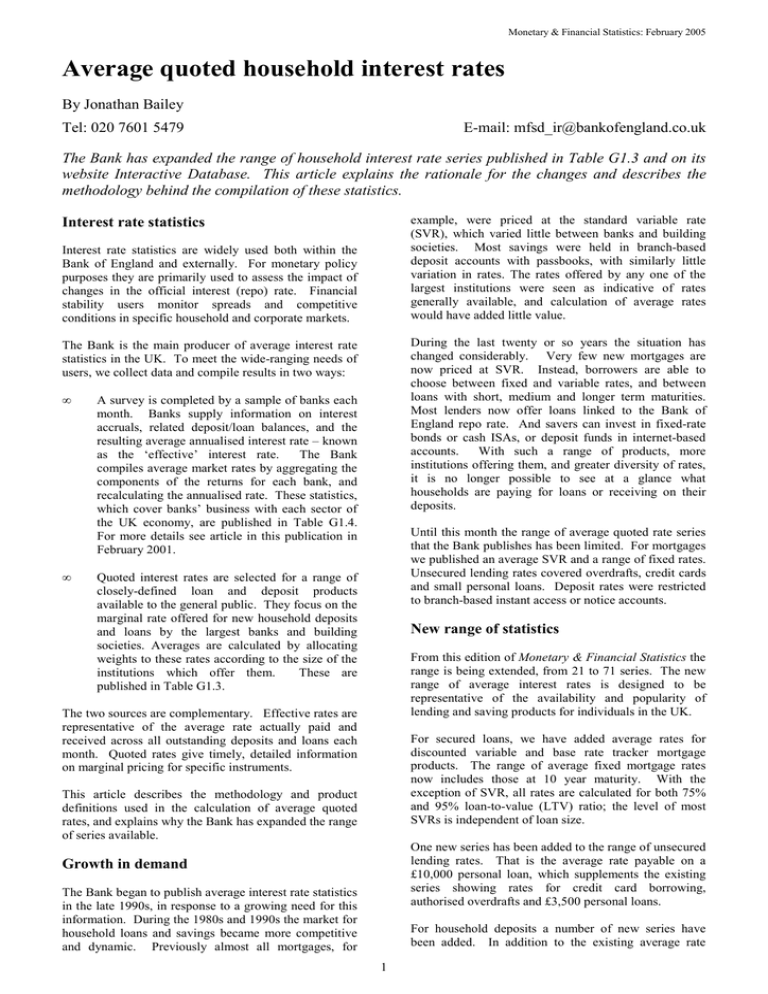Average quoted household interest rates
advertisement

Monetary & Financial Statistics: February 2005 Average quoted household interest rates By Jonathan Bailey Tel: 020 7601 5479 E-mail: mfsd_ir@bankofengland.co.uk The Bank has expanded the range of household interest rate series published in Table G1.3 and on its website Interactive Database. This article explains the rationale for the changes and describes the methodology behind the compilation of these statistics. example, were priced at the standard variable rate (SVR), which varied little between banks and building societies. Most savings were held in branch-based deposit accounts with passbooks, with similarly little variation in rates. The rates offered by any one of the largest institutions were seen as indicative of rates generally available, and calculation of average rates would have added little value. Interest rate statistics Interest rate statistics are widely used both within the Bank of England and externally. For monetary policy purposes they are primarily used to assess the impact of changes in the official interest (repo) rate. Financial stability users monitor spreads and competitive conditions in specific household and corporate markets. During the last twenty or so years the situation has changed considerably. Very few new mortgages are now priced at SVR. Instead, borrowers are able to choose between fixed and variable rates, and between loans with short, medium and longer term maturities. Most lenders now offer loans linked to the Bank of England repo rate. And savers can invest in fixed-rate bonds or cash ISAs, or deposit funds in internet-based accounts. With such a range of products, more institutions offering them, and greater diversity of rates, it is no longer possible to see at a glance what households are paying for loans or receiving on their deposits. The Bank is the main producer of average interest rate statistics in the UK. To meet the wide-ranging needs of users, we collect data and compile results in two ways: • • A survey is completed by a sample of banks each month. Banks supply information on interest accruals, related deposit/loan balances, and the resulting average annualised interest rate – known as the ‘effective’ interest rate. The Bank compiles average market rates by aggregating the components of the returns for each bank, and recalculating the annualised rate. These statistics, which cover banks’ business with each sector of the UK economy, are published in Table G1.4. For more details see article in this publication in February 2001. Until this month the range of average quoted rate series that the Bank publishes has been limited. For mortgages we published an average SVR and a range of fixed rates. Unsecured lending rates covered overdrafts, credit cards and small personal loans. Deposit rates were restricted to branch-based instant access or notice accounts. Quoted interest rates are selected for a range of closely-defined loan and deposit products available to the general public. They focus on the marginal rate offered for new household deposits and loans by the largest banks and building societies. Averages are calculated by allocating weights to these rates according to the size of the institutions which offer them. These are published in Table G1.3. New range of statistics From this edition of Monetary & Financial Statistics the range is being extended, from 21 to 71 series. The new range of average interest rates is designed to be representative of the availability and popularity of lending and saving products for individuals in the UK. The two sources are complementary. Effective rates are representative of the average rate actually paid and received across all outstanding deposits and loans each month. Quoted rates give timely, detailed information on marginal pricing for specific instruments. For secured loans, we have added average rates for discounted variable and base rate tracker mortgage products. The range of average fixed mortgage rates now includes those at 10 year maturity. With the exception of SVR, all rates are calculated for both 75% and 95% loan-to-value (LTV) ratio; the level of most SVRs is independent of loan size. This article describes the methodology and product definitions used in the calculation of average quoted rates, and explains why the Bank has expanded the range of series available. One new series has been added to the range of unsecured lending rates. That is the average rate payable on a £10,000 personal loan, which supplements the existing series showing rates for credit card borrowing, authorised overdrafts and £3,500 personal loans. Growth in demand The Bank began to publish average interest rate statistics in the late 1990s, in response to a growing need for this information. During the 1980s and 1990s the market for household loans and savings became more competitive and dynamic. Previously almost all mortgages, for For household deposits a number of new series have been added. In addition to the existing average rate 1 Monetary & Financial Statistics: February 2005 sample accounts for about 80% of household sight and time deposit balances. Individual interest rates used in the compilation of these series are selected from those publicised by each sampled bank and building society. Rates are included only for those institutions which advertise a product fitting the definition used for each series. series for branch-based instant access (unrestricted withdrawals) and notice accounts we now cover current accounts with overdraft facilities, and accounts operated mainly by post or telephone, or via the internet. Fixedrate bonds and cash ISAs have also been added. During the last few years more banks and building societies have been offering branch-based instant access accounts with restrictions on withdrawals during a specified time period. In general these attract a higher interest rate than those with no restriction. New series have been calculated to cater for this distinction. In doing so, the products included within the existing, unrestricted withdrawals series have been refined, resulting in revisions to these series back to January 1999. In the calculation of averages, the interest rates for individual banks and building societies are weighted using the monthly gross advances – or balances, where applicable – reported by those institutions. Users should note that these weights are general, in that, with the exception of credit card and overdrafts, they do not relate exactly to the specific product being measured. For example, the rates for building societies’ two-year fixed, 75% LTV mortgages are weighted by the monthly gross mortgage advances across all products by each sampled building society. The methodology therefore assumes that a bank’s market share is the same for each product within mortgages, unsecured personal loans and sight and time deposits. This assumption is due to the lack of available balance sheet information on the specified loan and deposit products. Although this is not ideal, the Bank is confident that the weights remain indicative of the relative importance of each sampled institution. With the exception of current account deposits and unsecured lending – where building societies are least operative – average interest rates are shown for banks and building societies separately as well as combined. Publication timetable Latest data in Table G1.3 relate to the previous period. For example, average rates for end-January 2005 are the latest included in this edition. The same series are published on the statistical interactive database, available on the Bank’s website. From 9 March 2005, average rates for the previous month will be published electronically on the seventh working day each month. Product definitions Strict product definitions are maintained to ensure comparability across individual interest rates contributing to each series. Annex A gives more details. Methodology A changing market Each series is derived from interest rates for relevant products available from a sample of the largest banks and building societies. The sample covers about 90% of all bank and building society gross mortgage advances to households, as measured by monthly balance sheet returns to the Bank (banks) and the Financial Services Authority (building societies). Coverage of total unsecured personal loan and credit card advances, and overdraft amounts outstanding, is also about 90%. The This note has explained the developments in related interest rate statistics introduced this month. The UK market for household borrowing and saving has changed substantially, and is likely to continue to evolve. The Bank will endeavour to ensure that its range of interest rates series remains consistent with current market developments, whilst maintaining the accuracy and timeliness of these statistics. 2 Monetary & Financial Statistics: February 2005 Annex A: Quoted rate product definitions All rates Unsecured loan rates Where more than one product fits the definition for any series, the rate selected is the most competitive and/or has the fewest conditions attached. Overdraft rates selected are those applicable for authorised overdrafts and are expressed in terms of EAR (Effective Annual Rate). The overdraft rate series is weighted by end-month outstanding overdraft balances. Products must be widely accessible. Those available through intermediaries only are excluded. Personal loan rates are expressed in terms of APR. No allowance is made for loan maturity or redemption penalties. The personal loan rate series are weighted by monthly gross personal loan advances. Rates selected relate to borrowing from, and deposits with, a sample of banks and building societies. Household business with other lenders and deposit takers is not covered. Credit card rates are expressed in terms of APR and apply to standard credit card purchases. If an institution offers more than one card, preference is given to the most popular (if known) or the card with a standard interest-free period. No allowance is made for short term incentives (such as 0% offers). The credit card rate series is weighted by monthly gross credit card advances. No allowance is made for associated fees/charges or cashbacks. Differences in frequency of interest calculation and application are ignored. Rates are those available at the end of each month. All rates are expressed gross of tax. Deposit rates Current accounts are those with overdraft and cheque facilities. Rates are selected for £1,000 balances. Secured loan (mortgage) rates Instant access accounts are branch-based. selected for £1,000 balances. Mortgage rates selected are those available to most borrowers. Products restricted to first-time buyers, for example, are excluded. Rates are those applicable for a minimum £60,000 loan. The headline advertised rate is selected, not the APR (Annual Percentage Rate). Rates are Time deposit accounts are also branch-based. Rates are selected for £10,000 balances in accounts requiring between 30 and 90 days’ notice to withdraw without penalty. Loan-to-value ratio (LTV) measures the loan size as a percentage of the property value; rates selected are the lowest available for loans of 75% and 95% LTV respectively. Deposit accounts operated by post or telephone, or via the internet, are not branch-based. Rates are selected for £10,000 balances. Reasonable time margins are allowed for fixed maturity products. For example, mortgages with maturity between 21 and 27 months qualify as a two year loan. Products with redemption penalties at the end of the fixed maturity period are excluded. Cash ISA deposit rates are selected for £3,000 balances. Rates selected for fixed-rate bonds have fixed initial maturity between one and two years. Rates are selected for £5,000 balances. Discounted variable rate mortgages are those attracting a short term (two or five year) discount relative to either the SVR or the Bank of England repo rate. Base rate tracker products are linked to the Bank of England repo rate. Minimum ten year maturity is stipulated on trackers to maintain the distinction with discounted variable rate products. For all deposit rate series any non-guaranteed bonuses are excluded. Rates for current accounts, instant access accounts and post/telephone and internet operated accounts are each weighted by end-month sight deposit balances. Rates for time deposit accounts and fixed-rate bonds are each weighted by end-month time deposit balances. Rates for cash ISAs are weighted by end-month cash ISA deposit balances. With one exception, all mortgage interest rate series are weighted by gross monthly mortgage advances. The exception is SVR, which is weighted by end-month outstanding mortgage balances. SVRs account for a significant proportion of outstanding mortgage loans, but few new mortgages. 3





